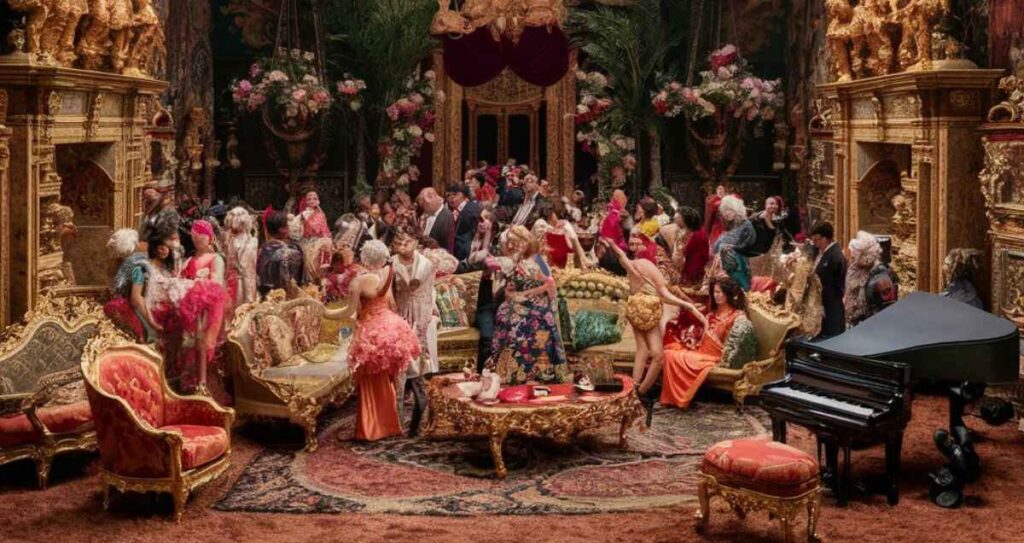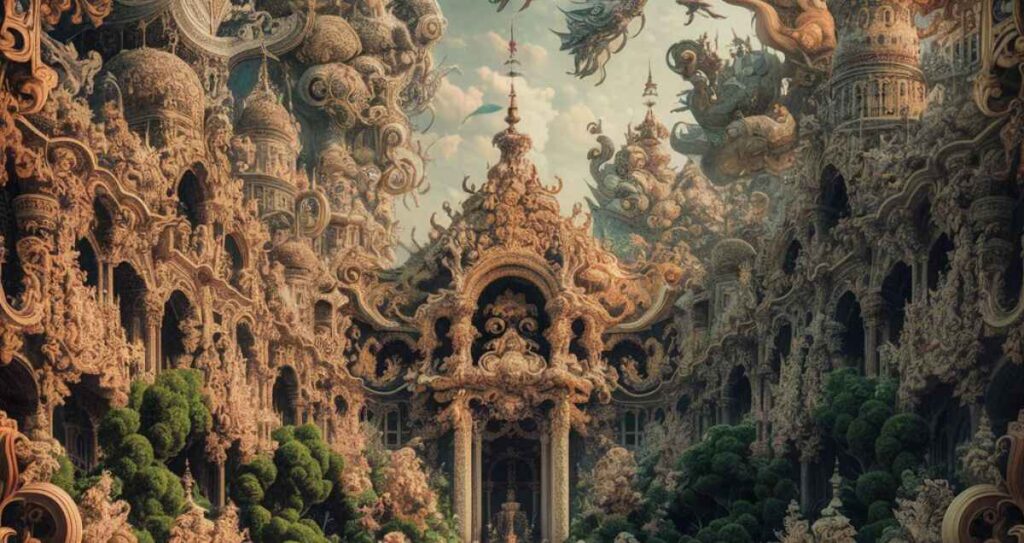The Opposite Of Minimalist Design is maximalism, a style that celebrates abundance, bold patterns, and vibrant colors. Unlike minimalism, which strips things down to essentials, maximalism encourages a rich, layered environment filled with personal expression.
Think of maximalism as the polar opposite of minimalism. Where minimalism focuses on simplicity and restraint, maximalism invites you to embrace “more is more.” It’s an exciting and dynamic way to design, where rules are flexible, and your personality takes center stage.
Maximalism thrives on contrasts, allowing you to mix different styles, eras, and items to reflect your personality. From bold artwork to layered rugs, it celebrates creativity and personal expression, making it perfect for those who want their home to feel dynamic and full of life. If you love color, patterns, and showcasing personal collections, maximalism could be the ideal design style for you.
What is Maximalism?

Maximalism is a design philosophy that embraces excess, contrasts, and richness. It’s about filling spaces with textures, colors, patterns, and personal items that tell a story. Opposite Of Minimalist Design, where “less is more,” maximalism believes that “more is more.”
While minimalism focuses on functionality and simplicity, maximalism celebrates expression, individuality, and a blend of styles. A maximalist room might feature vibrant artwork, layered rugs, a mix of modern and vintage furniture, and a collection of personal treasures all coexisting in harmony.
Maximalism vs. Minimalism: Key Differences
Understanding the Opposite Of Minimalist Design involves comparing the two distinct approaches. Let’s break down the core differences between minimalism and maximalism:
| Minimalism | Maximalism |
|---|---|
| Focuses on simplicity and function | Focuses on abundance and personality |
| Neutral color palettes dominate | Bold, vibrant colors and patterns |
| Clean lines, open spaces | Layered textures and intricate details |
| Minimal decoration and accessories | Personal collections, books, and art |
Minimalism asks, “What can we remove?” while maximalism asks, “What can we add?” Maximalism thrives on the tension of contrasting elements and allows you to display everything you love rather than hide it away.
How They Influence Emotions
- Minimalist spaces tend to evoke calmness and focus, ideal for people who find peace in open, uncluttered environments.
- Maximalist spaces are designed to energize and inspire. They bring a sense of excitement, creativity, and personality to any room.
Elements of Maximalist Design
Maximalism might seem overwhelming at first glance, but there are guiding principles that help bring the style together cohesively. Here are the key elements that define the Opposite Of Minimalist Design:
Bold Colors and Patterns
Maximalist interiors are a feast for the eyes. Think jewel tones, rich fabrics, and vibrant wallpapers. Instead of sticking to one color scheme, maximalism encourages mixing complementary and contrasting shades.
Tip: Don’t shy away from using multiple patterns in the same space. Florals, geometric prints, and abstract designs can all work together if balanced thoughtfully.
Layering
In maximalist homes, more is more. This means layering rugs, textiles, and even art. For example, you might hang a large painting over bold wallpaper or place a modern chair beside an antique side table.
Personal Collections
Maximalism is all about showcasing your personality. It’s not about following trends but rather highlighting your collections—whether it’s vintage cameras, books, or travel souvenirs.
Quote: “Maximalism is a reflection of life itself—messy, colorful, and full of stories.” — Rita Konig, Interior Designer
Mixing Eras and Styles
Unlike minimalism, which often adheres to a strict style, maximalism embraces eclecticism. You can mix mid-century modern with baroque furniture or throw in industrial elements next to ornate decor.
Art Everywhere
Art is crucial in maximalist homes. It doesn’t matter if it’s a gallery wall filled with paintings or sculptures placed strategically around the room; art creates focal points and adds character.
How to Incorporate Maximalism into Your Home

Incorporating maximalism into your space doesn’t have to happen all at once. Start small and build up to a fully vibrant room that embodies the Opposite Of Minimalist Design.
Step-by-Step Guide to Embracing Maximalism:
- Start with a Bold Statement Piece
Choose a large piece of furniture or artwork as your starting point. It could be a velvet couch, a colorful rug, or an oversized painting. - Layer in Textures and Patterns
Maximalism is tactile—add texture through pillows, throws, or curtains. Mix velvet with linen, silk with wool. Play with patterns by adding patterned cushions or geometric rugs. - Display Your Collections
This is your chance to bring out those treasured items that reflect your personality. Whether it’s an array of books, travel memorabilia, or antique finds, display them proudly. - Incorporate Art
Fill your walls with art, photographs, or mirrors. A gallery wall is a great way to bring in multiple elements while keeping it cohesive. - Mix Old and New
Maximalist spaces feel more dynamic when different styles come together. Mix vintage furniture with contemporary pieces, or traditional artwork with modern lighting.
Case Study: A Maximalist Living Room Transformation
To illustrate how maximalism can transform a space, let’s look at the makeover of a once minimalist living room into a maximalist retreat.
Before: Minimalist and Neutral
The living room originally featured clean lines, neutral tones, and sparse decoration. While it was functional, it lacked personality and warmth.
After: A Maximalist Dream
By adding bold colors, layered textures, and unique decor, the space transformed into a vibrant, cozy room that reflected the homeowner’s love for art and travel. Key elements included:
- A large emerald green velvet couch as the focal point.
- Layers of patterned rugs and throw blankets.
- A gallery wall featuring eclectic art from around the world.
- Vintage lamps mixed with modern coffee tables.
- Colorful, textured cushions bringing warmth and depth.
Benefits of Maximalism
There are several reasons why many people are turning to the Opposite Of Minimalist Design:
Personal Expression
Maximalism allows you to create a space that reflects who you are. Each item has personal significance, whether it’s art you love or furniture passed down through generations.
Creative Freedom
The rules are flexible in maximalism. You can mix styles, eras, and colors in a way that speaks to you without being bound by strict guidelines.
Comfort and Warmth
Maximalist homes often feel more lived-in and cozy. The abundance of textures and layers creates a welcoming atmosphere that minimalist spaces sometimes lack.
Creating Balance in Maximalist Spaces
Although maximalism encourages “more,” it’s essential to create balance to avoid overwhelming the space.
Tips for Achieving Balance:
- Stick to a Color Palette: While bold colors are a hallmark of maximalism, sticking to a loose color palette ensures the room feels cohesive.
- Focus on Focal Points: Too much can be distracting. Choose 1–2 focal points in the room and build around them, such as a large piece of furniture or a prominent artwork.
- Use Negative Space: Even in maximalism, negative space is essential. Let areas of the room “breathe” by not over-cluttering every corner.
Conclusion
Maximalism is the Opposite Of Minimalist Design, embracing the philosophy that more is more. It allows homeowners to express their personalities fully through bold colors, layered textures, and personal collections. Unlike minimalism, which focuses on simplicity, maximalism thrives on abundance and individuality.
Whether you’re just beginning your journey into maximalism or already have a maximalist heart, this design philosophy opens up a world of creativity and freedom. So go ahead—be bold, mix patterns, showcase your favorite pieces, and transform your home into a personal, vibrant masterpiece that reflects who you are.
David Mark is a seasoned home improvement expert and the creative mind behind DesignersParadise. With a keen eye for design and a passion for transforming spaces, David offers practical advice and innovative solutions for creating beautiful, functional homes. His insightful articles and tips aim to inspire and guide readers in enhancing their living environments, making every home a true reflection of style and comfort.
